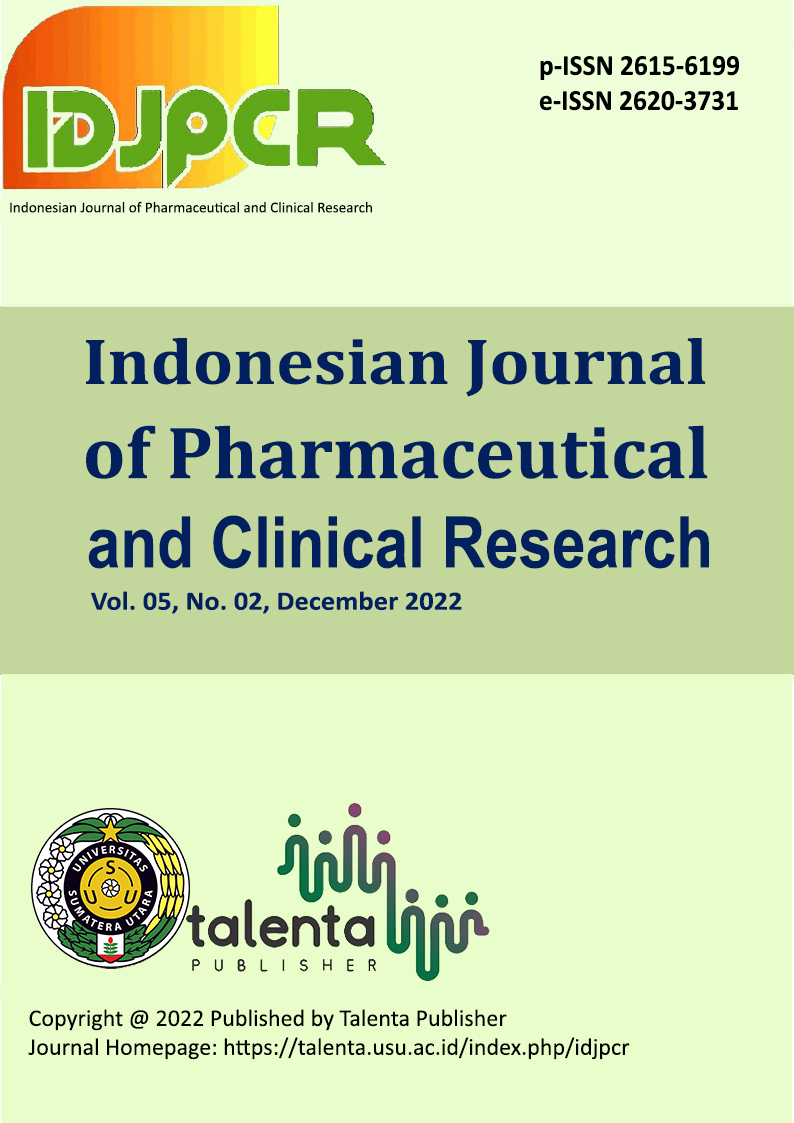Cytotoxic and Apoptotic Activities of Vernonia amygdalina Extract in HepG2 Cell Line
DOI:
https://doi.org/10.32734/idjpcr.v5i2.6350Abstract
Liver cancer is a malignant tumor originating from the development of chronic hepatitis or cirrhosis and is responsible for damage to the shape and function of the liver. The loss of the ability of conventional chemotherapy to inhibit the growth of cancer cells is a major focus in the world. Natural ingredients are the solution to this problem, for example the use of Vernonia amygdalina leaves. Vernonia amygdalina contains flavonoids, cardiac glycosides, and steroids/triterpenoids which are reported to have anticancer properties. This study aims to examined the activity of these plants as anticancer liver through cytotocix and apoptotic activity. Vernonia amygdalina ethanol extract (VAEE), Vernonia amygdalina ethyl acetate extract (VAEAE), and Vernonia amygdalina n-hexane extract (VAHE) were obtained from a multistage maceration process. The extracts were tested for cytotoxic activity by the MTT method on HepG2 cells. VAEAE had the best inhibitory concentration 50 (IC50) value of 19.91 ± 0.24 µg/mL. Apoptosis test was performed using double staining method. Subjective observations were made using a fluorescence microscope. It was seen that Vernonia amygdalina ethyl acetate extract was able to trigger apoptosis in HepG2 cells.
Downloads
References
K. Berginc and A. Kristl, “Transwell-grown HepG2 cell monolayers as in vitro permeability model to study drug-drug or drug-food interactions,†J. Med. Food, vol. 14, no. 1–2, pp. 135–139, 2011, doi: 10.1089/jmf.2010.0041.
S. Machana, N. Weerapreeyakul, S. Barusrux, K. Thumanu, and W. Tanthanuch, “Synergistic anticancer effect of the extracts from Polyalthia evecta caused apoptosis in human hepatoma (HepG2) cells,†Asian Pac. J. Trop. Biomed., vol. 2, no. 8, pp. 589–596, 2012, doi: 10.1016/S2221-1691(12)60103-8.
C. Martin-Cordero, A. Jose Leon-Gonzalez, J. Manuel Calderon-Montano, E. Burgos-Moron, and M. Lopez-Lazaro, “Pro-Oxidant Natural Products as Anticancer Agents,†Curr. Drug Targets, vol. 13, no. 8, pp. 1006–1028, 2012, doi: 10.2174/138945012802009044.
E. O. Farombi and O. Owoeye, “Antioxidative and chemopreventive properties of Vernonia amygdalina and Garcinia biflavonoid,†Int. J. Environ. Res. Public Health, vol. 8, no. 6, pp. 2533–2555, 2011, doi: 10.3390/ijerph8062533.
W. Johnson, P. B. Tchounwou, and C. G. Yedjou, “Therapeutic mechanisms of vernonia amygdalina delile in the treatment of prostate cancer,†Molecules, vol. 22, no. 10, pp. 1–13, 2017, doi: 10.3390/molecules22101594.
F. C. Wong, C. C. Woo, A. Hsu, and B. K. H. Tan, “The Anti-Cancer Activities of Vernonia amygdalina Extract in Human Breast Cancer Cell Lines Are Mediated through Caspase-Dependent and p53-Independent Pathways,†PLoS One, vol. 8, no. 10, 2013, doi: 10.1371/journal.pone.0078021.
M. F. Lubis, P. A. Z. Hasibuan, and U. Harapah, “PHYTOCEMICALS SCREENING AND CELL CYCLE ARREST ACTIVITY,†Asian J. Pharm. Res. Dev., vol. 7, no. 4, pp. 12–16, 2019.
R. Mahadevi and R. Kavitha, “Phytochemical and pharmacological properties of curcuma amada: A review,†Int. J. Res. Pharm. Sci., vol. 11, no. 3, pp. 3546–3555, 2020, doi: 10.26452/ijrps.v11i3.2510.
R. Akter, S. J. Uddin, I. D. Grice, and E. Tiralongo, “Cytotoxic activity screening of Bangladeshi medicinal plant extracts,†J. Nat. Med., vol. 68, no. 1, pp. 246–252, 2014, doi: 10.1007/s11418-013-0789-5.
D. Fachrunisa, P. A. Z. Hasibuan, and U. Harahap, “Cell cycle inhibition and apoptotic induction of vernonia amygdalina del. Leaves extract on MCF-7 cell line,†Open Access Maced. J. Med. Sci., vol. 7, no. 22, pp. 3807–3810, 2019, doi: 10.3889/oamjms.2019.509.
E. M. Kim, C. H. Jung, J. Kim, S. G. Hwang, J. K. Park, and H. D. Um, “The p53/p21 complex regulates cancer cell invasion and apoptosis by targeting Bcl-2 family proteins,†Cancer Res., vol. 77, no. 11, pp. 3092–3100, 2017, doi: 10.1158/0008-5472.CAN-16-2098.
J. Joseph and E. J. Moses, “In vitro Anticancer Effects of Vernonia amygdalina Leaf Extract and Green-Synthesised Silver Nanoparticles,†pp. 3599–3612, 2021.
D. Satria, J. Silalahi, G. Haro, S. Ilyas, and P. A. Z. Hasibuan, “Chemical analysis and cytotoxic activity of N-hexane fraction of Zanthoxylum acanthopodium DC. fruits,†Rasayan J. Chem., vol. 12, no. 2, pp. 803–808, 2019, doi: 10.31788/RJC.2019.1225180.
P. Anjelisa, Z. Hasibuan, J. Chrestella, and D. Satria, “Combination effect of ethylacetate extracts of Plectranthus amboinicus ( Lour .) spreng . with doxorubicin againts T47D breast cancer cells Innovare ( LOUR .) SPRENG . WITH DOXORUBICIN AGAINTS T47D BREAST CANCER CELLS,†no. January, 2015.
“Apoptosis : A Review of Programmed Cell Death,†pp. 495–516, 2007, doi: 10.1080/01926230701320337.
K. W. Luo et al., “Anticancer effects of imperatorin isolated from Angelica dahurica: Induction of apoptosis in HepG2 cells through both death-receptor- and mitochondria-mediated pathways,†Chemotherapy, vol. 57, no. 6, pp. 449–459, 2012, doi: 10.1159/000331641.
A. Korga et al., “Apigenin and hesperidin augment the toxic effect of doxorubicin against HepG2 cells,†BMC Pharmacol. Toxicol., vol. 20, no. 1, pp. 1–13, 2019, doi: 10.1186/s40360-019-0301-2.
J. Cox and S. Weinman, “Mechanisms of doxorubicin resistance in hepatocellular carcinoma,†Hepatic Oncol., vol. 3, no. 1, pp. 57–59, 2016, doi: 10.2217/hep.15.41.
D. Satria, J. Silalahi, G. Haro, S. Ilyas, and P. A. Z. Hsb, “Antioxidant and antiproliferative activities of an ethylacetate fraction of picria fel-terrae Lour. herbs,†Asian Pacific J. Cancer Prev., vol. 18, no. 2, pp. 399–403, 2017, doi: 10.22034/APJCP.2017.18.2.399.
S. D. A. Abel and S. K. Baird, “Honey is cytotoxic towards prostate cancer cells but interacts with the MTT reagent: Considerations for the choice of cell viability assay,†Food Chem., vol. 241, no. April 2017, pp. 70–78, 2018, doi: 10.1016/j.foodchem.2017.08.083.
P. A. Z. Hasibuan, U. Harahap, P. Sitorus, and D. Satria, “The anticancer activities of Vernonia amygdalina Delile. Leaves on 4T1 breast cancer cells through phosphoinositide 3-kinase (PI3K) pathway,†Heliyon, 2020, doi: 10.1016/j.heliyon.2020.e04449.
J. jie Liu, M. Lin, J. ying Yu, B. Liu, and J. ku Bao, “Targeting apoptotic and autophagic pathways for cancer therapeutics,†Cancer Lett., vol. 300, no. 2, pp. 105–114, 2011, doi: 10.1016/j.canlet.2010.10.001.
S. L. Fink and B. T. Cookson, “Apoptosis, pyroptosis, and necrosis: Mechanistic description of dead and dying eukaryotic cells,†Infect. Immun., vol. 73, no. 4, pp. 1907–1916, 2005, doi: 10.1128/IAI.73.4.1907-1916.2005.
Downloads
Published
How to Cite
Issue
Section
License
Copyright (c) 2022 Indonesian Journal of Pharmaceutical and Clinical Research

This work is licensed under a Creative Commons Attribution-ShareAlike 4.0 International License.
The Authors submitting a manuscript do so on the understanding that if accepted for publication, copyright of the article shall be assigned to Indonesian Journal of Pharmaceutical and Clinical Research (IDJPCR) and Faculty of Pharmacy as well as TALENTA Publisher Universitas Sumatera Utara as publisher of the journal.
Copyright encompasses exclusive rights to reproduce and deliver the article in all form and media. The reproduction of any part of this journal, its storage in databases and its transmission by any form or media, will be allowed only with a written permission from Indonesian Journal of Pharmaceutical and Clinical Research (IDJPCR).
The Copyright Transfer Form can be downloaded here.
The copyright form should be signed originally and sent to the Editorial Office in the form of original mail or scanned document.









